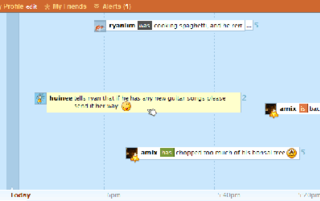
Neil Richard MacKinnon Gaiman is an English author of short fiction, novels, comic books, graphic novels, audio theatre, and screenplays. His works include the comic book series The Sandman and the novels Good Omens, Stardust, Anansi Boys, American Gods, Coraline, and The Graveyard Book. In 2023, he starred as the voice of Gef the talking mongoose in the black comedy film Nandor Fodor and the Talking Mongoose.

A blog is an informational website consisting of discrete, often informal diary-style text entries (posts). Posts are typically displayed in reverse chronological order so that the most recent post appears first, at the top of the web page. Until 2009, blogs were often the work of a single individual, occasionally of a small group, and often covered a single subject or topic. In the 2010s, "multi-author blogs" (MABs) emerged, featuring the writing of multiple authors and sometimes professionally edited. MABs from newspapers, other media outlets, universities, think tanks, advocacy groups, and similar institutions account for an increasing quantity of blog traffic. The rise of Twitter and other "microblogging" systems helps integrate MABs and single-author blogs into the news media. Blog can also be used as a verb, meaning to maintain or add content to a blog.

Steven Karl Zoltán Brust is an American fantasy and science fiction author of Hungarian descent. He is best known for his series of novels about the assassin Vlad Taltos, one of a disdained minority group of humans living on a world called Dragaera. His recent novels also include The Incrementalists (2013) and its sequel The Skill of Our Hands (2017), with co-author Skyler White.
Web fiction is written works of literature available primarily or solely on the Internet. A common type of web fiction is the web serial. The term comes from old serial stories that were once published regularly in newspapers and magazines.
Blog fiction is an online literary genre that tells a fictional story in the style of a weblog or blog. In the early years of weblogs, blog fictions were described as an exciting new genres creating new opportunities for emerging authors, but were also described as "notorious" in part because they often uneasily tread the line between fiction and hoax. Sometimes blog fictions are republished as print books, and in other cases conventional novels are written in the style of a blog without having been published as an online blog. Blog fiction is a genre of Electronic literature.

Tao Lin is an American novelist, poet, essayist, short-story writer, and artist. He has published four novels, a novella, two books of poetry, a collection of short stories, and a memoir, as well as an extensive assortment of online content. His third novel, Taipei, was published by Vintage on June 4, 2013. His nonfiction book Trip: Psychedelics, Alienation, and Change was published by Vintage on May 1, 2018. His fourth novel, Leave Society, was published by Vintage on August 3, 2021.

X, formerly and still colloquially known as Twitter, is a social media website based in the United States. With over 500 million users, it is one of the world's largest social networks. Users can share and post text messages, images, and videos known historically as "tweets". X also includes direct messaging, video and audio calling, bookmarks, lists and communities, and Spaces, a social audio feature. Users can vote on context added by approved users using the Community Notes feature. Although the service is now called X, the primary domain name 'twitter.com' remains in place as of January 2024, with the 'x.com' URL redirecting to that address.

Maureen Johnson is an American author of young adult fiction. Her published novels include series leading titles such as 13 Little Blue Envelopes, The Name of the Star, Truly Devious, and Suite Scarlett. Among Johnson's works are collaborative efforts such as Let It Snow, a holiday romance novel of interwoven stories co-written with John Green and Lauren Myracle, and a series of novellas found in New York Times bestselling anthologies The Bane Chronicles, Tales from the Shadowhunter Academy, and Ghosts of the Shadow Market.
Microblogging is a form of blogging using short posts without titles known as microposts. Microblogs "allow users to exchange small elements of content such as short sentences, individual images, or video links", which may be the major reason for their popularity. Some popular social networks such as Twitter, Mastodon, Tumblr, Koo, and Instagram can be viewed as collections of microblogs.

identi.ca was a free and open-source social networking and blogging service based on the pump.io software, using the Activity Streams protocol. Identi.ca stopped accepting new registrations in 2013, but continues to operate alongside several other pump.io-based hosts provided by E14N which continue to accept new registrations.

GNU social is a free and open source software microblogging server written in PHP that implements the OStatus standard for interoperation between installations. While offering functionality similar to Twitter, GNU social seeks to provide the potential for open, inter-service, and distributed communications between microblogging communities. Enterprises and individuals can install and control their own services and data.

Plurk is a free social networking and micro-blogging service that allows users to send updates through short messages or links, which can be up to 360 text characters in length.

A hashtag is a metadata tag that is prefaced by the hash symbol, #. On social media, hashtags are used on microblogging and photo-sharing services such as Twitter or Tumblr as a form of user-generated tagging that enables cross-referencing of content by topic or theme. It is still sometimes known as the pound sign. For example, a search within Instagram for the hashtag #bluesky returns all posts that have been tagged with that term. After the initial hash symbol, a hashtag may include letters, numerals, or underscores.
The tables below compare general and technical information for some notable active microblogging services, and also social network services that have status updates.
Yahoo! Meme was a microblogging site launched by the Yahoo Latin America team in August 2009. The platform was conceived as a mash up of functionality derived from Twitter and Tumblr. Its beta version was originally launched to a Brazilian audience with later versions expanding into Spanish, English, Chinese, and Indonesian audiences.
Tencent Weibo was a Chinese microblogging (weibo) website launched by Tencent in April 2010, and was shut down on September 28, 2020. Users could broadcast a message including 140 Chinese characters at most through the web, SMS or smartphone.
Reblogging is the mechanism in blogging which allows users to repost the content of another user's post with an indication that the source of the post is another user.
Weibo is a general term for microblogging, but normally understood as Chinese-based mini-blogging services, including social chat sites and platform sharing.

Twitterature is a literary use of the microblogging service of Twitter. It includes various genres, including aphorisms, poetry, and fiction written by individuals or collaboratively. The 280-character maximum imposed by the medium, upgraded from 140 characters in late 2017, provides a creative challenge.
Micro.blog is a microblogging and social networking service created by Manton Reece. It is the first large multi-user social media service to support the Webmention and Micropub standards published by the World Wide Web Consortium, and is part of the Fediverse, supporting ActivityPub.










